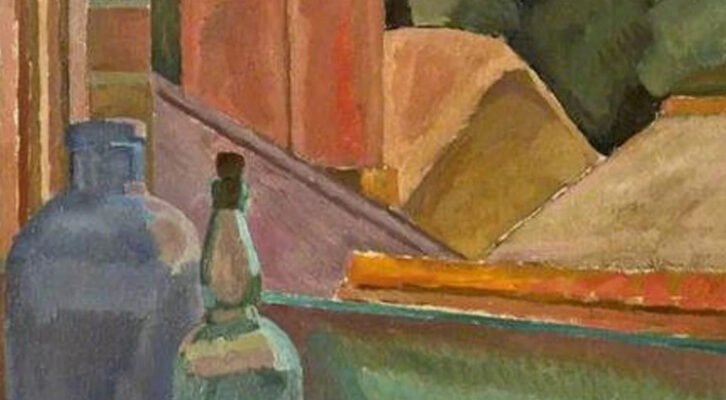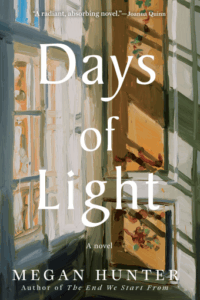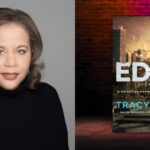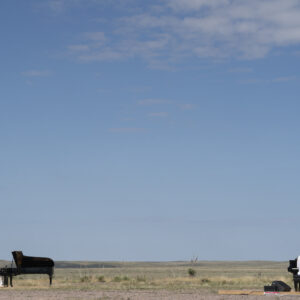
Art Imitates Life: Finding Creative Freedom in the Fusion of Fiction and Biography
Megan Hunter on the Process Behind Her Novel of Vanessa Bell, Angelica Garnett and the Bloomsbury Group
I was promoting my first book when the alert for my third arrived, like a bell, a quiet alarm warning me to pay attention. It was 2017, and I was speaking at Charleston in Sussex, the home of painters Vanessa Bell and Duncan Grant. It was late, and after the event we were offered a nighttime tour of the house, the light hushed, the sense of trespass on the recent past heightened by darkness. I found myself lowering my voice, walking slowly, overwhelmed by the plethora of beautiful objects and art works, every surface patterned, painted, filled with life.
As we went from room to room our guide related biographical fragments from those who had lived there: Vanessa Bell’s daughter, Angelica Garnett, who had not known who her real father was until she was eighteen, and who had married her father’s erstwhile lover—David Garnett—a man who had decided to marry her on the day of her birth.
I had created something that was life-like, but did not have the pulse and exposed nerves of fiction. It was the clothed woman in the painting, not the nude I had hoped for.
These stories were rich, as dense with association as our surroundings were, and yet it was not their strangeness that attracted me, but a sense of resonance. I had not lived the same life, but somehow Angelica Garnett’s experiences chimed with my own, and with some wider, more expansive sense: the urge to write fiction. As soon as I had finished my second novel, The Harpy, I immersed myself in the world of these extraordinary people, reading letters, diaries, biographies.
In these I found the particular, nonfictional shape of real, messy lives: illness and confusion and misunderstanding, the way time is shaped—or misshaped—by decision and accident. I liked the way that certain details in biography stayed with me, as though stuck under my fingernails, forming part of my own accumulation of memory. It became tempting to write a biographical fiction drawn from these complex, evocative times; I found myself writing of Angelica being painted as a child by Vanessa, imagining how it would feel for each of them, the particularity of this mother-daughter, artist-subject gaze.
During the pandemic, I was living for much of the time in the England of the 1930s, immersed in the atmosphere of Angelica Garnett’s childhood and adolescence, the feeling of Charleston’s garden around her, the heavy emotional weather described in her memoir Deceived with Kindness. I began to craft a narrative that sprang from these early days into subsequent decades, following the shape of her life across the twentieth century. And alongside this, I wrote about “the writer,” a figure very close to myself, also living in the countryside, with children who needed her more intensely than ever, whom she was shepherding through their own historical aberration. Here was life on the page: “real” life as lived by figures only a few generations behind me, and my own day to day existence and history, barely altered. I would stare at photographs of Angelia and Vanessa, of Angelia and her own daughters, hoping to catch from the images some essence of existence, a spirit that would find its way into my own work.
During these years, I surrounded myself with Vanessa Bell’s paintings; prints, postcards and tiny, black and white images in books. One of these, Interior with Two Women (in Frances Spalding’s wonderful biography of Vanessa Bell) fascinated me the most, and gave me a working title for the book that was emerging. In the painting, two women sit on a sofa, one naked, the other clothed. They seemed to me to be the same woman: one a naked, desiring, embodied self, and her polite, tea-pouring alternate persona. It spoke to me of motherhood, and domesticity, of what Vanessa Bell, in a letter to her sister Virginia Woolf, called the “animal and remorseless” passion of maternal instinct. So much of the book, as it was emerging, seemed to be about the ecstasy and antagonism of the mother-daughter bond (Angelica herself had four daughters), and its particular relation to the life of an artist.
As Adrienne Rich writes in Of Woman Born, in the mother-daughter dyad the “materials are here for the deepest mutuality and the most painful estrangement.” Each generation of women defines themselves by and against their mothers, and for Angelica this was especially fraught and complex: what did it mean, to be the child of an artist? And how did this shape the course of one’s life? These questions propelled me through the pandemic and out the other side, where I found myself with a draft novel that was somehow both full of life—real incident, real people, biographical texture upon texture—and lacking it. I had created something that was life-like, but did not have the pulse and exposed nerves of fiction. It was the clothed woman in the painting, not the nude I had hoped for.
I had discovered a way forward for my work—and life—where, in the meeting of fiction and fact, art and biography, a new form of freedom emerged.
And so began the painstaking process of beginning again, of allowing myself to move into a space where biography could be an inspiration, rather than a template, paintings ekphrastic jumping off points into lines of enquiry, rather than direct source material. I began, counter-intuitively, to allow more of my life into the story, now that it was entirely fictional, more of my deepest longings and fascinations filling its pages. And in this new work something else became paramount: form itself, which began to emerge as a new sentence for me, something much fuller than the pared-back prose I had previously written. It began to seem that I was writing something closer to a historical sentence, one that tried to learn from Woolf, rather than to describe her.
s Rebecca Birrell said when she interviewed me at a conference celebrating Bell’s work earlier this year: “instead of writing about Bell and Woolf, you began to write with and through them.” I can think of no better way to describe the process that became Days of Light: a sense of no longer being in the historical shadow, but rather in the historical illumination of a way of painting, writing, and being in the world. I was, increasingly, not writing according to history but counter to it, this new, playful relationship allowing me to follow the way my own autobiography entwined with the legacies of Bell, Woolf and Garnett.
As I wrote Days of Light my own life began to change rapidly: my marriage ended, I lost a close family member, and my career moved in new directions, as the film was released of my first book, The End We Start From. I had a strong sense of the unexpected nature of life, biographical unpredictability returning in a real, visceral form. Some of the turns of my own history—particularly a decision to train for ordination in the Anglican church in my twenties, and then to leave that training—began to enter the book in new and transformed ways. I found myself writing about faith, and the place for this alongside art. I found myself writing about love—new and old, about the way people’s needs and desires can change across a lifetime.
And perhaps most crucially I found myself writing about how it is never too late; the fact that life can change radically at any point, just as the writing of a book can. I had discovered a way forward for my work—and life—where, in the meeting of fiction and fact, art and biography, a new form of freedom emerged.
__________________________________

Days of Light by Megan Hunter is available from Grove Press, an imprint of Grove Atlantic.
Megan Hunter
Megan Hunter is a prizewinning novelist, dramatist and screenwriter. Her first novel, The End We Start From (2017) was shortlisted for Novel of the Year at the Books Are My Bag Awards, longlisted for the Aspen Words Prize, was a Barnes and Noble Discover Awards finalist and won the Foreword Reviews Editor’s Choice Award. It was adapted into a major motion picture by Alice Birch, starring Jodie Comer and directed by Mahalia Belo. Her second novel, The Harpy (2020), was Indie Book of the Month; she is currently adapting it for television with Red Planet Pictures. In 2024 her dramatic monologue Salt of the Earth premiered at Venice Film Festival. Megan’s other writing has appeared in the White Review, the TLS, Literary Hub, Vogue, Elle, BOMB, and elsewhere. She lives in Cambridge, UK.



















